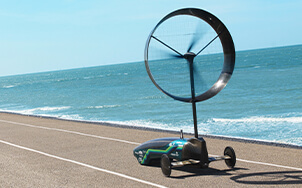If we can predict it, we can plan for it
Every year, the lives of 46 million people are threatened by floodingSource from storm surges. The Intergovernmental Panel on Climate Change predicts that by 2050Source, extreme sea-level events like storm surges that happen once a century will instead strike once a year.
As extreme events like tropical cyclones get more frequent and intense, early warning systems will save countless lives. Over the history of climate/weather forecasting, the limits of computing power put a ceiling on how accurate predictions could be. But that’s starting to change.
Predicting extreme weather requires capturing massive amounts of data in real-time through IoT systems. Then IT and data experts, climate scientists, and urban planners need to work together to store, process, analyze and see patterns in the data to anticipate major climate events hundreds or even thousands of days before they strike.
Three standout organizations are using Lenovo solutions to push the forecasting frontier: the Malaysian Meteorological Department (MMD), Zhejiang Meteorological Service, and the Climate Change and Hydrological Extremes Project (ClimEx).
Before Lenovo stepped in, MMD – Malaysia’s national weather service—delivered three-day weather forecasts at 3-kilometer resolution. They wanted to extend their forecast range and up the resolution of their models. To accomplish these goals, they needed a 27-fold increase in computing power.
Using a Lenovo High Performance Computing (HPC) system with liquid cooling technology, MMD tripled forecast resolution and extended its forecast range from three to seven days at an improved resolution of 1-kilometer.
MMD can use this information to warn the public of extreme weather, while public agencies use their data to plan everything from irrigation to disaster responses.
Lenovo provides end-to-end services to organizations like MMD that use meteorological data for public safety. World-class technicians stand ready to help with technical issues as they arise – keeping MMD confident as they apply HPC solutions to get ahead of a stormy future.
Storms are also top of mind at Zhejiang Meteorological Service (ZMS), which sits in China’s monsoon zone, buffeted by tornadoes, typhoons, and gale-force winds.
One of 5 Chinese meteorological bureaus, ZMS is tasked with forecasting turbulent weather events and mitigating their effects. Yet, its storage system and complex server infrastructure slowed things down while raising costs. Lenovo’s data center solutions allowed them to put everything in one place, with a consolidated hybrid storage infrastructure that’s agile enough to handle challenges from radar data to distributing weather information.
FEATURED SOLUTIONS

Analytics & AI

Lenovo High Performance Computing

Lenovo End-to-End Services
Lenovo solutions will help ZMS to distribute weather services faster and more efficiently, mitigating the impact of extreme weather events on the social and economic fabric of Zhejiang Province.
The HPC innovation doesn’t stop with MMD and ZMS. Across the world, ClimExSource – a collaboration between German and Canadian supercomputing facilities, universities, and water agencies – is using cutting-edge environmental prediction techniques to shape water management and plan for flooding. The project creates meteorological simulations on powerful Lenovo supercomputers at the Leibniz Supercomputing Centre (LRZ).
Lenovo HPC has allowed the research team at LRZ to create meteorological projections that go broad and deep, gaining thousands of years’ worth of climate data and beating the traditional tradeoff between the length and area a simulation can coverSource and level of detail.
With their high spatial resolution and ability to analyze thousands of data points at once, ClimEx models help scientists accurately predict the timing and path of oncoming weather events. Municipalities can use these projections to prepare — halting construction in some areas or building floodwalls in others—sometimes with a years-long head start.
Every passing minute moves us closer to a future shaped by climate change, but with the help of HPC, Analytics & AI and other technology solutions, researchers can understand extreme weather events before they strike. After all, only if we see it coming can we more fully prepare.












